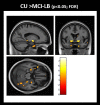Longitudinal atrophy in prodromal dementia with Lewy bodies points to cholinergic degeneration
- PMID: 35415608
- PMCID: PMC8994111
- DOI: 10.1093/braincomms/fcac013
Longitudinal atrophy in prodromal dementia with Lewy bodies points to cholinergic degeneration
Abstract
Mild cognitive impairment with the core clinical features of dementia with Lewy bodies is recognized as a prodromal stage of dementia with Lewy bodies. Although grey matter atrophy has been demonstrated in prodromal dementia with Lewy bodies, longitudinal rates of atrophy during progression to probable dementia with Lewy bodies are unknown. We investigated the regional patterns of cross-sectional and longitudinal rates of grey matter atrophy in prodromal dementia with Lewy bodies, including those who progressed to probable dementia with Lewy bodies. Patients with mild cognitive impairment with at least one core clinical feature of dementia with Lewy bodies (mean age = 70.5; 95% male), who were enrolled in the Mayo Clinic Alzheimer's Disease Research Center and followed for at least two clinical evaluations and MRI examinations, were included (n = 56). A cognitively unimpaired control group (n = 112) was matched 2:1 to the patients with mild cognitive impairment by age and sex. Patients either remained stable (n = 28) or progressed to probable dementia with Lewy bodies (n = 28) during a similar follow-up period and pathologic confirmation was available in a subset of cases (n = 18). Cross-sectional and longitudinal rates of grey matter atrophy were assessed using voxel-based and atlas-based region of interest analyses. At baseline, prodromal dementia with Lewy bodies was characterized by atrophy in the nucleus basalis of Meynert both in those who remained stable and those who progressed to probable dementia with Lewy bodies (P < 0.05 false discovery rate corrected). Increase in longitudinal grey matter atrophy rates were widespread, with greatest rates of atrophy observed in the enthorhinal and parahippocampal cortices, temporoparietal association cortices, thalamus and the basal ganglia, in mild cognitive impairment patients who progressed to probable dementia with Lewy bodies at follow-up (P < 0.05 false discovery rate corrected). Rates of inferior temporal atrophy were associated with greater rates of worsening on the clinical dementia rating-sum of boxes. Seventeen of the 18 (94%) autopsied cases had Lewy body disease. Results show that atrophy in the nucleus basalis of Meynert is a feature of prodromal dementia with Lewy bodies regardless of proximity to progression to probable dementia with Lewy bodies. Longitudinally, grey matter atrophy progresses in regions with significant cholinergic innervation, in alignment with clinical disease progression, with widespread and accelerated rates of atrophy in patients who progress to probable dementia with Lewy bodies. Given the prominent neurodegeneration in the cholinergic system, patients with prodromal dementia with Lewy bodies may be candidates for cholinesterase inhibitor treatment.
Keywords: MRI; atrophy; dementia with Lewy bodies; mild cognitive impairment; prodromal DLB.
© The Author(s) 2022. Published by Oxford University Press on behalf of the Guarantors of Brain.
Figures






References
-
- Durcan R, Donaghy P, Osborne C, Taylor JP, Thomas AJ. Imaging in prodromal dementia with Lewy bodies: Where do we stand? Int J Geriatr Psychiatry. 2019;34:635–646. - PubMed
Grants and funding
LinkOut - more resources
Full Text Sources
